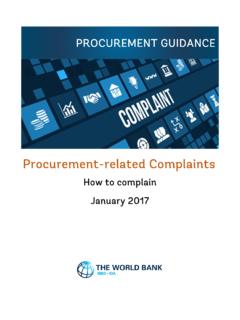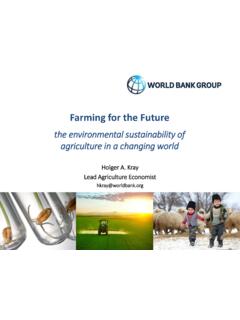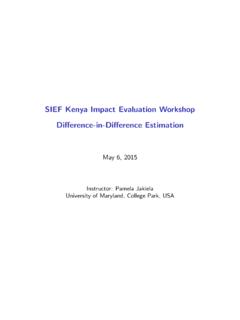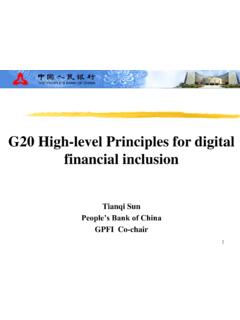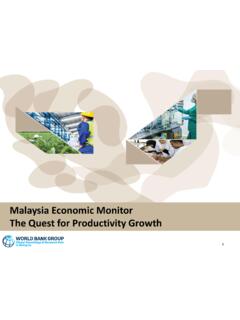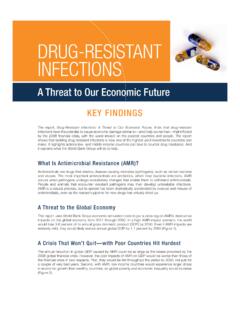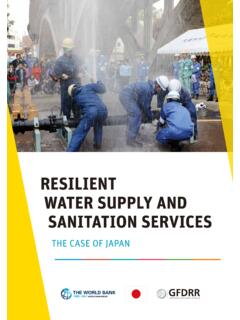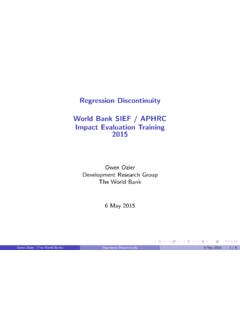Transcription of PHILIPPINES ECONOMIC UPDATE: INVESTING IN THE FUTURE
1 PHILIPPINES ECONOMIC UPDATE: INVESTING IN THE FUTURE . April 2018. Macroeconomics, Trade and Investment Global Practice East Asia and Pacific Region PREFACE. The PHILIPPINES ECONOMIC Update summarizes key ECONOMIC and social developments, important policy changes, and the evolution of external conditions over the past six months. It also presents findings from recent World Bank analysis, situating them in the context of the country's long-term development trends and assessing their implications for the country's medium-term ECONOMIC outlook . The update covers issues ranging from macroeconomic management and financial-market dynamics to the complex challenges of poverty reduction and social development. It is intended to serve the needs of a wide audience, including policymakers, business leaders, private firms and investors, and analysts and professionals engaged in the social and ECONOMIC development of the PHILIPPINES . The PHILIPPINES ECONOMIC Update is a biannual publication of the World Bank's Macroeconomics, Trade, and Investment Global Practice (MTI), prepared in partnership with the Poverty & Equity, Finance, Competitiveness & Innovation, and Social Protection & Labor Global Practices (GPs).
2 Birgit Hansl (Lead Economist and Program Leader) and Ndiame Diop (Practice Manager for the MTI GP) guided the preparation of this edition. The team consisted of Kevin Chua (Economist), Kevin Cruz (Research Analyst). and Rong Qian (Senior Economist) from the MTI GP, Isaku Endo (Senior Financial Sector Specialist) from the Finance, Competitiveness and Innovation GP, Gabriel Demombynes (Program Leader), Xubei Luo (Senior Economist) and Sharon Faye Alariao Piza (Economist) from the Poverty & Equity GP. Thilakaratna Ranaweera (Consultant) provided technical support on the growth projection. The report was edited by Oscar Parlback (Сonsultant), and the graphic designer was Robert Waiharo (Сonsultant). Peer reviewers were Jasmin Chakeri (Program Leader, LCC1C) and Yutaka Yoshino (Lead Economist and Program Leader, AFCE1). Logistics and publication support were provided by Maria Consuelo Sy (Program Assistant). The Manila External Communications Team, consisting of David Llorito (Communications Officer) prepared the media release, dissemination plan, and web-based multimedia presentation.
3 The team would like to thank Mara Warwick (Country Director for Brunei, Malaysia, PHILIPPINES and Thailand) for her advice and support. The report benefited from the recommendations and feedback of various stakeholders in the World Bank as well as from the government, the business community, labor associations, academic institutions, and civil society. The team is very grateful for their contributions and perspectives. The findings, interpretations, and conclusions expressed in the PHILIPPINES ECONOMIC Update are those of the World Bank and do not necessarily reflect the views of the World Bank's executive board or any national government. This report went to press on April 13, 2018. If you wish to be included in the email distribution list for the PHILIPPINES ECONOMIC Update and related publications, please contact Maria Consuelo Sy For questions and comments regarding the content of this publication, please contact Birgit Hansl Questions from the media should be addressed to David Llorito For more information about the World Bank and its activities in the PHILIPPINES , please visit I.
4 ABBREVIATIONS AND ACRONYMS. 2 TBA Two-tier budgeting approach BOP Balance of payments BPO Business process outsourcing BSP Bangko Sentral ng Pilipinas CALABARZON Cavite, Laguna, Batangas, Rizal, and Quezon CPI Consumer price index FDI Foreign direct investment GOCC Government-owned and controlled corporation IT Information technology PREXC Program expenditure classification TFP Total factor productivity TRAIN Tax Reform for Acceleration and Inclusion TVET Technical and vocational education and training UACS Unified accounts code structure VA Value added II. Table of Content PREFACE .. I. List of Figures .. III. List of Tables .. V. List of Boxes .. VI. EXECUTIVE SUMMARY .. VII. Part I: RECENT ECONOMIC AND policy DEVELOPMENTS .. 1. Growth: Benefitting from the Global Recovery .. 2. The Exchange Rate and the External Sector: Impacts from an Improving External 6. Financial Markets and Monetary policy : Keeping the policy Rate Steady despite Rising Inflation.
5 10. Fiscal policy : Preparing for the Public Investment Increase .. 12. Employment and Poverty: A Tight Labor Market with Limited Real Wage Growth .. 16. Part II: outlook AND 21. Growth 22. Poverty and Shared Prosperity outlook .. 29. Risks and policy Challenges .. 30. Part III: THE MISSING LINKS TO HIGHER SHARED PROSPERITY IN THE PHILIPPINES .. 34. 35. Drivers of Poverty Reduction .. 37. The Remaining Challenge: Low-quality Jobs and Slow Real Wage Growth .. 39. The Importance of Education in Labor Market Participation and Wage Growth .. 44. Conclusion .. 49. References .. 51. List of Figures Figure 1: Strong Exports Contributed to Growth among Regional Peers in 2017 .. 2. Figure 2: and Helped Sustain Growth in the PHILIPPINES .. 2. Figure 3: In the PHILIPPINES , Exports Drove Growth While Investment Significantly Slowed .. 3. Figure 4: While Manufacturing Expanded and Agriculture Recovered .. 3. Figure 5: Average capacity utilization in the manufacturing sector has reached historic highs in early 2018.
6 5. III. Figure 6: In 2017 , the Peso Has Depreciated in Both Nominal and Real Terms .. 7. Figure 7: Making It One of the Worst Performing Regional Currencies .. 7. Figure 8: Recovery in the External Environment Supported the Growth in Exports in 2017 .. 9. Figure 9: Yet Continued Higher Import Growth Led to a Widening Current Account Deficit .. 9. Figure 10: Exports of Electronics (index, 2010 = 100) .. 10. Figure 11: Inflation Rose Sharply and Surpassed in March 2018 the Ceiling of the Central Bank's Target Range .. 11. Figure 12: Credit Has Sustained Its Double-digit Growth Rates .. 11. Figure 13: National Government Fiscal Balance, 12. Figure 14: Fiscal Balance, Percent of GDP, 2000-17 .. 13. Figure 15: Public Expenditures as a Share of Nominal GDP 2013-17 .. 13. Figure 16: Public Expenditures by ECONOMIC Classification (Actual Disbursements), Percent of Total Expenditures, 2013-17 .. 14. Figure 17: Public Expenditures by Functional Classification (Obligation Basis), Percent of Total Expenditures, 2013-17.
7 14. Figure 18: Government Revenue Efforts, 2006-16 .. 15. Figure 19: Tax Revenue Efforts, 2006-16 .. 15. Figure 20: The Government Financed Its Deficit through Domestic Borrowing .. 16. Figure 21: The Overall Debt-to-GDP Ratio Remained Unchanged from 2016 to 2017 .. 16. Figure 22: The Unemployment Rate Remained Around 5 percent .. 18. Figure 23: While the Labor Force Participation Rate Remained Below the 10-year Average .. 18. Figure 24: Changes in Real Daily Wages, 2007-17 .. 19. Figure 25: The Philippine Economy is Projected to Grow at percent in 2018 and 2019.. 22. Figure 26: Global ECONOMIC Growth, 2000-20 .. 24. Figure 27: Output Gaps, 24. Figure 28: The Largest Share of Domestic Bank Credit is Channeled to Real Estate and 29. Figure 29: The Manufacturing and Finance Sectors are among the Favorite Destinations of Foreign Direct Investment.. 29. Figure 30: Sustained ECONOMIC Growth Makes It Likely That Poverty Reduction Will Continue.
8 30. Figure 31: Selected Macroeconomic Indicators .. 32. Figure 32: National Poverty Rates and Number of Poor .. 35. Figure 33: Poverty Trends Based on National and International Poverty Lines .. 35. IV. Figure 34: Prosperity Improvement in the PHILIPPINES Compared to the East Asia Pacific Region .. 36. Figure 35: Contribution of Income Sources to Poverty Reduction, 2006 38. Figure 36: Millions of Workers Transitioned out of Agriculture .. 38. Figure 37: Greater Earnings in Services and Manufacturing than in Agriculture .. 38. Figure 38: Poverty Rate by Employment Sector of Household Heads .. 40. Figure 39: Poverty Rate by Employment Status of Household Heads .. 40. Figure 40: Working-age Population, Labor Force, and Employment Growth .. 41. Figure 41: GDP, Employment, and Real Wage Growth .. 41. Figure 42: Share of Employment of the Poor by Sector .. 42. Figure 43: Share of Employment of an Average Filipino by Sector .. 42. Figure 44: Intersectoral Labor Allocation in Select East Asian Countries.
9 42. Figure 45: Countries Changes in the Composition of Employment Status Over Time .. 44. Figure 46: Rate of Return for Another Year of Education .. 45. Figure 47: Rate of Return for Education by Education Level .. 45. Figure 48: Marginal Effect on the Probability of Wage Employment with an Additional Year of Schooling by Gender and Location .. 46. Figure 49: Marginal Effect on the Probability of Wage Employment with an Additional Year of Schooling by Education Level .. 46. Figure 50: Youth (20 29 years old) Education Levels Across Income 47. Figure 51: Educational Attainment Rate among 22 24 Year-olds by Income Quintiles, 2006-15 48. Figure 52: Educational Attainment Rate among 22 24 Year-olds by Gender, 2006-15 .. 48. Figure 53: Reasons for Not Attending Elementary School among 6- to 11-Year-olds in the Poorest Quintile, 48. Figure 54: Reasons for Not Attending High School among 12- to 15-Year-olds in the Poorest Quintile, 48.
10 List of Tables Table 1: Balance of Payments, 8. Table 2: Real GDP Growth Rates, 2015-2020 .. 24. Table 3: ECONOMIC indicators for the Baseline Projection .. 28. Table 4. Poverty Rate in Selected East Asian Countries .. 36. V. Table 5. Employment and Earnings Status, Percent .. 43. Table 6. Employment, Unemployment, and Daily Earnings by Educational Attainment, Perent 44. List of Boxes Box 1. The Global Economy is Experiencing a Broad-based and Maturing Cyclical Recovery .. 5. Box 2: Electronics Export Growth in the East Asia Pacific Region .. 9. Box 3: Recent Public Expenditure Profile of the PHILIPPINES .. 13. Box 4: Public Revenue in the East Asia Pacific Region .. 15. Box 5: Building Human Capital through the K-12 Basic Education Program .. 19. Box 6: The Global ECONOMIC 23. Box 7: Initiatives to Modernize the Budgeting Process .. 26. Box 8: The Next Steps for the Government's Tax Reform Program.. 33. VI. EXECUTIVE SUMMARY. In 2017 , the PHILIPPINES was among the top three growth performers in the East Asia region.
